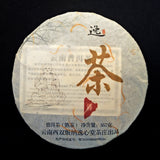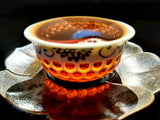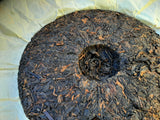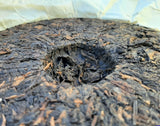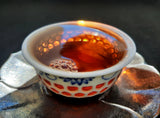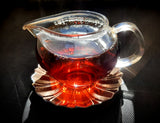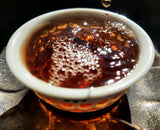Only 1 available.
This Menghai tea produces a luminous, mahogany brew, with a rich, fruity, deep, complex, sweet aroma. Its flavor is clean, sweet, and earthy, with a full body and a pronounced "iron" flavor. It has elements of cherry, almond, wood, granite, and a hint of smokiness. Its texture is silky, its qi relatively neutral, and it leaves a ringing sweetness (yun) on the palate.
This tea is extremely long-brewing, lasting up to two dozen brews.
This tea was harvested in 2012, and pressed in 2016. One cake consists of approximately 357 grams.
Nomenclature: The Chinese name of this cake is 禪茶/禅茶 Chán Chá
There is a saying:
禪茶一味/禅茶一味. - Chán chá yī wèi.
Roughly, this translates to "Zen and tea have the same flavor," or "Zen and tea have the flavor of oneness."
禪/禅 - Chán - This was the Chinese form of Daoist-influenced Buddhism that gave rise to Zen (which was, itself, influenced by Shinto). About fifteen hundred years ago, a meditation master now known as Dà Mó, or Bodhidharma, is said to have walked from India to China, in order to assist in the clear transmission of Buddhist teachings to China. Upon his arrival in China, he was granted an audience with the emperor. During this meeting, the emperor was quite displeased with the answer Da Mo gave in response to one of his questions, and immediately banished Da Mo from his vicinity. Having just walked from India, Da Mo was in no hurry to return, and headed instead to the Shaolin Temple. He was dismayed to see that the monks there were in poor health, appearing sickly and emaciated, and would often fall asleep while meditating. He resolved to help these monks, and went up to a cave in the mountains to meditate on the matter. Here he practiced the single-pointed meditation style, known in India as Dyana, of which he was a master. Here, he sat, facing the cave wall, for seven years. During this time, he is said to have cut off his own eyelids, to prevent himself from falling asleep, which are said to have then grown into tea bushes. (This lack of eyelids is one reason all depictions of him appear so fiercely intense.) Over the course of this meditation, he developed a system of Qigong to benefit the health of the monks. As there were many bandits in the area, this Qigong, practiced by the monks of the Shaolin Temple, gradually gave rise to a martial art, based in the internal principles of Da Mo's Qigong. This was the birth of Shaolin Gongfu (frequently spelled "Kung Fu"), which eventually spread throughout the world. In addition, the Buddhist teachings of Da Mo heavily influenced the monks of the Shaolin Temple, giving rise to a new form of Buddhism in China. The name of the single-pointed meditation that Da Mo taught, Dyana, became sinified as "Chan," since "Dyana" is not a word that works in the Chinese language. Ultimately, this form of Buddhism spread to Japan, where its name was changed once again, this time to fit the Japanese language, at which point it became "Zen." In 1191, it was the monk Eisai who brought Zen to Japan, along with green tea seeds from China. Thus, Japanese Zen could be seen as the twin of Japanese tea culture, in that they were born together, of the same act. Thus, from its origins through its development, Zen and tea have been linked, to the point that the two are said to have the same flavor, namely, the flavor of oneness.
茶 - Chá - Tea. The top of this character (艹) comes from a pictograph of plants growing out of the ground. The middle of this character is often said to represent a mountain, though it also resembles the Chinese character for person (人). This is fitting as, when we drink tea, we invite each tea as an honored guest. In this way, each tea can be seen and honored as an individual, with its own energy and personality. The bottom of this character (木) is the image of a tree. Together, these create the image of tea trees, growing on the mountainside, each its own person, in a sense.







